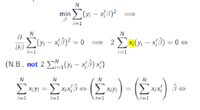Hi!
I am not sure if this forum is the appropriate place to post this question, but here it goes...
This is about OLS (Ordinary Least Squares Estimator), where we choose a slope in such a way that I minimize the squared residuals.
In order to minimize this function, the professor puts a derivative with respect to Beta (the slope) equals to zero. So far so good.
In the step I have put in yellow, I see he applies the Chain Rule, so 2 is behind the Summation symbol due to power rule and then he derived the inner function.
The problem is that I don't understand why the result is Xi and not Xi' (which means X transposed). Does anyone know this?

I am not sure if this forum is the appropriate place to post this question, but here it goes...
This is about OLS (Ordinary Least Squares Estimator), where we choose a slope in such a way that I minimize the squared residuals.
In order to minimize this function, the professor puts a derivative with respect to Beta (the slope) equals to zero. So far so good.
In the step I have put in yellow, I see he applies the Chain Rule, so 2 is behind the Summation symbol due to power rule and then he derived the inner function.
The problem is that I don't understand why the result is Xi and not Xi' (which means X transposed). Does anyone know this?

